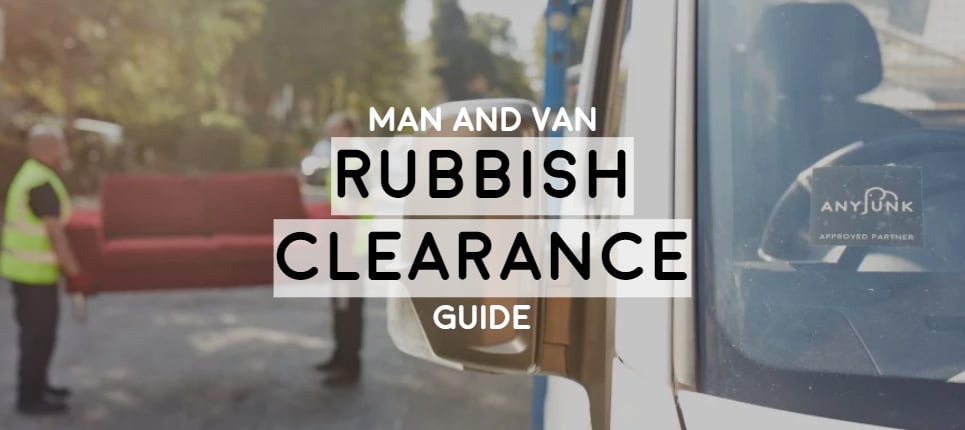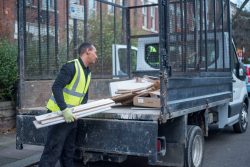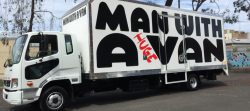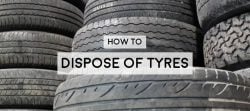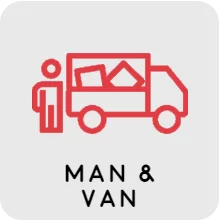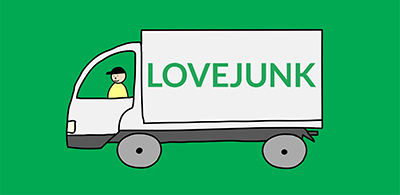Man & Van Rubbish Clearance Guide
Man & van Rubbish Clearance is a cost effective, easy and eco-friendly way of disposing of your bulky waste, but surprisingly many people never even consider it. Here is our ultimate 2020 guide to how it works and the key questions to consider when you use it.
- Man & Van Rubbish Clearance definition
- Who provides man and van rubbish clearance?
- Waste types – what bulky waste types can be removed?
- Weight restrictions – do I need to worry about how heavy the waste is?
- Van types & sizes – what types are used and how big are they?
- Labour – what labour is included?
- Rates – how does pricing work and how much should I expect pay?
- Collection time & location – do I have to be present when the rubbish is collected?
- Collection size different – what if the actual collection size is different to the size booked?
- Moving other items – can the crew move my stuff from one location to another for me?
- Messy floor – how to avoid rubbish messing up my drive or lawn?
- License – what sort of licensing is there?
- Paperwork – should I expect any documentation for the waste collection?
- Disposal & recycling – where does the waste go?
- When to use and when not to use a man and van for bulky waste
Man & van rubbish clearance is generally defined as the loading and removal of bulky waste from a property by a man & van crew. The service covers collection of waste from anywhere on the property, loading it into a truck, sweeping up any loose material, and delivering the waste to a licensed disposal facility. Rates are based on the volume of waste removed and cover the labour, transport and disposal fees. Man & van rubbish clearance should not be confused with the ‘wait & load’ service offered by skip companies which does not include any labour. It is one of the many options people can use for Rubbish Removal.
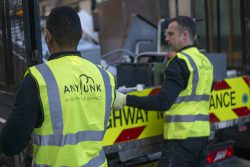
A variety of organisations offer the service. These include specialist man & van rubbish clearance companies (of which AnyJunk is obviously our favourite!), one-man bands, skip hire companies, traditional house moving companies (who take away junk at the same time as doing your move), charities, and your local council.
Every council is obliged to offer a subsidised collection service for bulky household items to its residents. Some offer this for free, but most charge – and in recent years those charges have steadily risen. The service is normally restricted to furniture, appliances and other household ‘junk’, rather than builders and home improvement waste. This is because the latter is considered ‘trade waste’ and not something the council should subsidize. Service levels tend to be pretty basic so you will often have to wait a week or so for an appointment and all items must be placed outside. Nonetheless it is normally cheaper than a private service, so if you don’t mind the inconvenience, it’s definitely worth checking your local council’s website to see what they offer.
Private waste companies, although likely to cost more than the council, take the full range of bulky waste (rather than just household junk) and, unlike council crews, their teams will collect from anywhere on the property (including upstairs and the back garden). Plus they will be available at much shorter notice and offer narrow arrival times, so you don’t need to wait around all day. Prices of one man bands may be cheaper than larger, professional organisations. But if you do opt for a one-man band always check they have a waste carrier license and their insurance covers them for waste removal.
Many charities like British Heart Foundation offer a free collection service for good quality, genuinely resalable items (which for sofas and upholstered furniture also means having proper fire certification). So be sure to contact them if you have anything decent. But for the stuff that you know is actual rubbish, please don’t waste their or your time.
Bulky waste means in the context of man & van rubbish clearance any non-hazardous waste that can comfortably be lifted by two people. This includes builders waste, fly-tipped waste, bulky appliances (including domestic fridges), furniture, bric-a-brac, carpet, plasterboard, garden waste and household junk. For waste licensing, health & safety and insurance reasons, most firms will not remove the following hazardous items:
- Asbestos (read our guide on safe disposal of asbestos)
- Batteries
- Clinical or medical waste, including syringes
- Fluorescent tubes
- Commercial fridges, freezers and air conditioning units
- Gas canisters and gas bottles
- Hazardous & toxic materials
- Oil, petrol, diesel
- Paint & Cans of paint
- Tyres
Man & van clearance firms typically don’t like and aren’t best suited to jobs with lots of very heavy demolition or excavation waste like soil, rubble and cement (often referred to as ‘inert waste’). This is because their collection vehicles are usually light goods vehicles. Light goods vehicles, although cheaper and easier to run than heavy goods vehicles, must by law never weigh more than 3.5 tonnes. An empty LGV truck, crew and fuel weighs 2.0 – 2.5 tonnes, which leaves 1.0 – 1.5 tonnes capacity for the waste (this figure is called the vehicle’s ‘payload’). That payload is fine if the waste is a mix of bulky materials but not if it contains mostly inert waste. So, if you do have lots of very heavy, dense demolition or excavation waste, you will probably be better offer hiring a skip.
Just like cars, vans vary substantially in size and type. The main types of vans and trucks used for bulky waste are:
- Box Tipper – the most popular vehicle for bulky waste, a box or caged tipper (pictured above) has a solid or mesh box at the back to contain the waste and has a hydraulic tipper mechanism to pour out the contents when the van goes to the tip. This helps minimise the time the crew needs to spend offloading waste. The reason why the box is often metal cage rather than solid side is too keep weight to a minimum and maximise payload. The volume of the box on a waste tipper truck is typically 10 cubic yards – 14 cubic yards. .
- Luton – a Luton vehicle has a large solid side box (often made out of fibreglass to keep it light) at the back which extends over the cab. This type of van provides lots of storage space and is most often used by removal companies when people move homes. It isn’t ideal for waste because the sides aren’t very strong (so can get damaged when heavy items are thrown in) and the lack of tipper means the team has to handball everything when they get to the tip. The volume of a Luton can vary widely.
- Transit – transit vans are popular with delivery companies and tradespeople as they are cheap, compact and easy to drive. They have sliding door at the side and a rear door. They don’t have a tipping mechanism so take longer to empty than a tipper but the sides are made of metal, so more robust than a Luton. In the context of rubbish clearance they are most often used by people who offer other services at the same time, like delivery or a trade. Other than slow offloading, their main issues for waste removal are low ceiling and also dust and grit from builders’ waste getting stuck into the sliding door mechanism. Transit van volume are 8 yards to 14 yards.
- Flatbed lorry – flatbeds are trucks with a flat bed at the back with very low or no sideboards. They are designed to carry heavy items and favoured by scaffolders, builders merchants and tool hire businesses. They are not great for bulky waste (unless you are removing lots of very heavy inert waste) because the low sides prevent you from stacking lots of bulky items safely.
The labour is a key element of a man & van rubbish clearance. The service and price includes clearing the waste from anywhere on the property and loading it onto the van. It will normally also include a sweep-up. Although crews will often be happy to break things down a bit to make them easier to move or take up less space in the truck, do not expect them to undertake substantial demolition work or dismantling (eg. sawing a sofa in half to fit through doors). If you need this extra service, be prepared to pay more for their time and effort.
Rates for rubbish clearance are based on the volume of bulky waste removed and cover the labour, transport and disposal fees. Volume is normally referred to in cubic yards or fractions of the truck. If you’re comparing prices and someone is quoting fractions of truck, remember that trucks have different sizes and therefore cheaper might not actually mean better if it’s a smaller truck. The important figure to ask for is how big is the box at the back (not how long is the truck or whether it is a 3.5 tonner or 7.5 tonner – this is just jargon designed to bamboozle the uninformed!). You can see images of different sizes of sizes with prices in our Booking funnel.
Note that a few special items – the most common are fridges, TVs and mattresses – will incur a supplement because they need to be disposed of differently to general waste and this costs the waste clearance company a bit more in disposal fees.
As a rough guide, a full 14 yard truck clearance should cost around £360 (£300 ex VAT) and ½ truck (ie. 7 cubic yards) around £220 (£180 ex VAT). Collection of single furniture item should cost around £40 – £50.
FYI, the national average cost of a 6 cubic yard skip (before adding permit fees and parking suspensions if placed on a road) is around £226 (£188 ex VAT).
Provided there is access to the junk and it is clearly identified what materials are to be taken and what are to stay, then there is no need for you to be present. Clearance companies can collect from anywhere on the property as long as there is access. You could leave the waste outside in an accessible place, for example your front garden, to allow for easy access if you can’t be present.
If your collection size is bigger or smaller than you ordered then the collection crew should let you know before they start and charge or credit you the difference. AnyJunk offers customers the option of a refund if the job ends up larger than booked and you’d prefer to cancel.
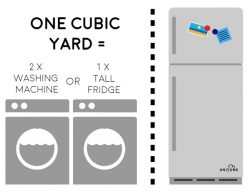
It totally depends on the firm as to whether or not they’re prepared to move items for you. Generally, it’s not a good idea to use a rubbish company to move your stuff because the vans can be dirty. On top of this, the teams are used to moving rubbish rather than valuable items meaning they probably won’t take as much care as a specialist removal company. If you require an A to B removal service, we recommend visiting the British Association of Removers.
Most companies will give the area a thorough sweep up before they leave. However, if some of your waste is particularly messy (e.g. rubble, earth, broken tiles) and you are concerned about leaving it on your lawn or driveway before the collection, we recommend storing it in rubble bags or stacking it on a tarpaulin or ground sheet.
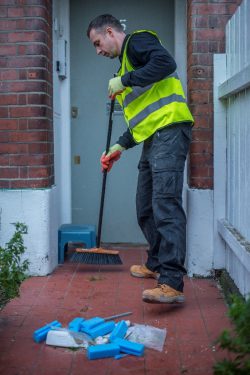
To remove your waste a man & van firm or sole trader must be registered with the Environment Agency or SEPA and have a valid waste carrier license. They should also be insured to do the work and we recommend if you are allowing crew into your home you ask for photo ID and DBS checks (which used to be known as CRB checks).
The key paperwork when someone removes your waste is a waste transfer note. This is a document that records the responsibility of the waste being transferred from one party to another. Strictly speaking if the waste is being collected from a domestic property then any form of written confirmation is sufficient but if the form removing your waste is an experienced and professional organisation then they should provide a waste transfer note as matter of course. If not, alarm bells should start to ring!
Once collected, unless passed on for reuse, the waste will be taken to a licensed commercial waste transfer station where it is then recycled, sent to waste-to-energy or landfilled. Read more about bulky waste’s journey.
A man & van rubbish clearance is a great way to get rid of a wide range of bulky waste materials from your home. Anything that’s too big for your bin – from furniture, appliances and bric-a-brac to flooring, DIY waste and builders waste. In most instances the service is considerably cheaper than a skip and all the labour is included, so you can literally just point and the waste will be removed from anywhere on the property.
The main weakness of a man & van solution is its inability to handle large amounts of heavy, dense waste like soil and bricks, because of vehicle weight restrictions and also the time it takes to load a lot of that sort of loose, messy material. In those circumstances, we recommend hiring a skip instead since weight is less of an issue and it’s also ideal for containment. Note if you don’t have space at your property for a skip, then consider requesting a wait & load service from your skip provider instead.
Other resources
If you liked this guide, here are a few others that you may find useful:





